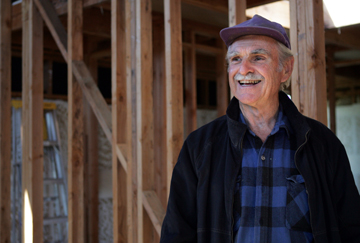Purification ceremony marks movement on project
In two years, Don Belt has planted 2,400 trees. In a few decades
many of them will be full-grown. Belt will not live long enough to
see it.
Purification ceremony marks movement on project
In two years, Don Belt has planted 2,400 trees. In a few decades many of them will be full-grown. Belt will not live long enough to see it.
“This is my last project,” Belt said. “I’m an old guy, I may not get to see this when the trees get to be 50 or 60 feet.”
Belt, a Hollister resident, is the director of the Hollister Japanese Garden Project. The Garden is a five-acre Japanese garden on Belt’s property in Hollister.
“The Japanese name for this garden is going to be Shinsen-in,” Belt said. “Shinsen-in means sacred waters. The corporate name is the Hollister Japanese Garden.”
On Saturday, Oct. 27, a Buddhist priest from Seattle, Taijo Imanaka, will perform a ground purification ritual at the Garden.
The purpose of the ritual is to purify the ground before the Buddhist temple, bell tower and Shinto shrine are built in the Garden, according to Belt.
The temple and bell tower are still in the design phase, but some construction work has already started. An old barn is being turned into a reception center, Belt said.
“This seemed like a perfect time to do this,” he said, referring to the ceremony, “because we’re moving ahead now.”
Imanaka spoke slowly, by phone, a few days before the ceremony. English is not his first language. His words were so precise that he seemed to think about every word before he said it.
“Before we build a house or temple on your property in Japan,” Imanaka said, “you need to purify the ground where you build. Not just to purify. It’s also a celebration.”
In the ritual salt, rice, and white sand are all thrown onto the ground, Imanaka said. Each substance has a symbolic meaning
“Salt is to purify the ground,” Imanaka said. “Rice is to enrich wealth. Rice is the symbol of wealth.”
Each particle of white sand symbolizes a particle of light. In Buddhism, light symbolizes unity or oneness because beams of light have no boundaries, Imanaka said.
Because soil is made up of the plants and animals that once lived in a place, sake, a Japanese rice wine, is poured onto the ground to respect and entertain their spirits, according to Imanaka.
“All sentient beings under the ground are glad to accept the blessing,” Imanaka said. “They will bless the building and the people who will live and come to the building.”
The purification ritual is a way for people to acknowledge their dependence on the environment.
“Some think this kind of ritual is very primitive,” Imanaka said. “This is the way to show our gratitude to the environment. We human beings cannot survive just on our own.”
This dependence means that everything in the universe is connected, according to Imanaka.
“Without the sunlight, any plants cannot grow,” Imanaka said. “Without any plants, any animals cannot grow. And if so, any human beings cannot grow. Everything in the universe is connected. This is not fantasy, just fact.”
This ceremony will be different than other purification rituals, Imanaka said. Normally only a Buddhist priest would participate in the ritual, but this time attendants will throw the various substances onto the ground.
“If I, a Buddhist priest, alone do it,” Imanaka said, “the attendants have the possibility just to be an observer of a ritual that is not familiar to them.”
If Imanaka explains the purpose of the ritual and attendants have the chance to participate, the ceremony will become everyone’s ritual. It will enable participants to celebrate the temple.
It is important for as many people as possible to celebrate the temple, Imanaka said.
The genesis of the Garden goes back 50 years.
“I lived in Japan for two years, in 1957 and 1958,” Belt said. “That’s sort of where the seed was planted. I love Japan. I love the people, the architecture.”
The Garden will feature a Buddhist temple, bell tower, Japanese tea house, a Shinto shrine, and a koi pond with a working waterfall. A monk-in-residence will live on the property full time.
“We want ultimately a place where people can enjoy a beautiful garden,” Belt said, “and also a place where people can come and enjoy regular meditation. [The temple] won’t be like a church. It will be a meditation place.”
Unlike many nonprofits, Shinsen-in staff will not have to worry about how to maintain the garden, Belt said.
He owns a medical building and rent money from the building will pay for the upkeep of Shinsen-in, he said.
“I would say in five years it should look like a Japanese park,” Belt said, referring to the Garden. “We don’t have anything in the area like it.”










